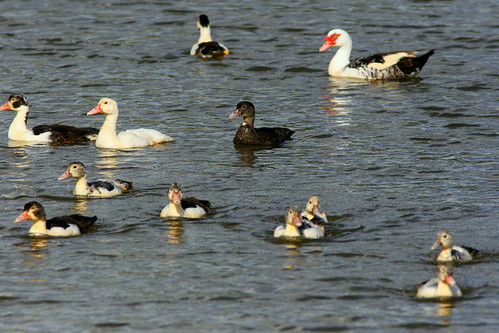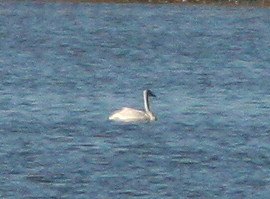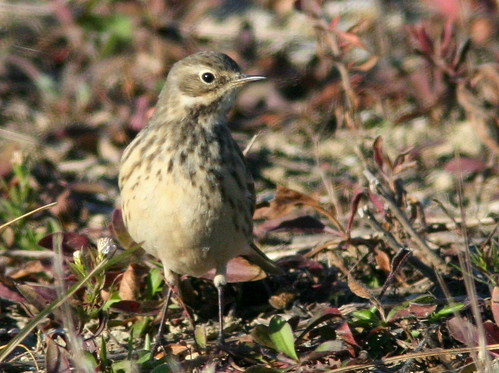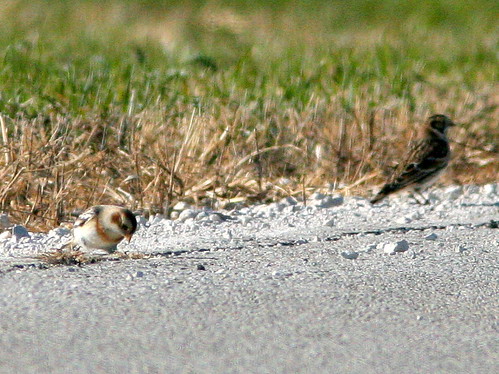Upon arriving back in Florida, we were greeted by a family of Muscovy Ducks that live on the lake behind our home. These ducks have met with varying reproductive success. Thanks to predation by bass, turtles, hawks, illness and even infanticide, relatively few ducklings make it to adult life. See Muscovy Survival Muscovy Mortality Purposeful Infanticide
Back in early September, momma duck hatched out 13 downy ducklings. Here she is with part of her brood: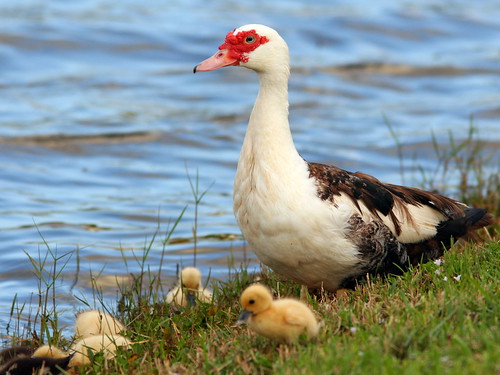
Only two of the ducklings were entirely yellow. They were destined to become pure white as adults:
Here she is now, with the surviving eleven babies, now well-feathered. Note that one of the white ducklings did not survive:
As our stay in northeastern Illinois drew to a close, we still hoped to see a few migrating birds that were not likely to appear back in Florida. The arrival of Fox Sparrows and juncos signaled the end of the passage of birds such as warblers and tanagers that fly through Illinois on their way to the neotropics. Now our hopes rose in anticipation of seeing some of the hardy birds from the far north that spend the winter there.
On our “wanted” list were Northern Shrike, Winter Wren, Nelson’s, LeConte, American Tree and Harris’s Sparrows, Snow Buntings, Lapland Longspurs, crossbills and Purple Finches. Trumpeter Swans and Whooping Cranes were also outside bets. All are birds whose migratory habits usually do not coincide with ours. Except for the Nelson’s Sparrow, we have seen all of them before. We saw the shrike, longspurs and Snow Buntings in Manitoba, but not yet in the lower 48 States. Normally, we have returned to Florida by this time of year, so we planned to take advantage of our delayed departure. Unfortunately, cold and windy weather kept us pretty much homebound during our final week, and Mary Lou developed a bad cold that dampened her desire to venture out into the field.
As I described in last week’s post, during a brief visit to Nelson Lake/Dick Young Kane County Forest Preserve I spotted a distant swan. It had a slight grayish tint to its plumage, indicative of an immature bird. The most common swan in the area is the introduced non-migratory Mute Swan. “If you hear hoof beats, think horses, not zebras” is generally good advice, so the challenge was to distinguish this swan from Tundra and Trumpeter Swans, both winter visitors from the north.Trumpeters nest not too far away, in northern Wisconsin, while Tundra Swans breed above the Arctic Circle.
This swan tended to hold its neck up rather straight, instead of in a gentle “S” curve that is typical of Mute Swans. The base of its neck did have a tight “S” curve close to its body that, from a distance, appeared to make its neck stick up from further back on the body. It also tended to keep its bill pointing relatively horizontal; Mute Swans’ bills often point more downward. Therefore, this swan was very likely one of our natives, either a Tundra or a Trumpeter Swan.
It was about a half mile away, and I did not have a spotting scope. My view through 10×42 binoculars was very similar to the highly cropped photos I obtained with my 420 mm lens system, which is equivalent to about 8x magnification. I again welcome any suggestions as to this bird’s identification, if possible with these images. Interestingly, only three days after I flew back to Florida, seven Trumpeter Swans (5 adults and 2 young) were identified by experts at this same location! Three out of the four people who commented on the photo believed it to be a Tundra Swan. I am re-posting the swan’s photo here just in case anyone missed it.
The base of the swan’s bill seemed pale, and the bill lacked the knob seen on adult Mute Swans (click on photo for more views):
A Northern Shrike had been seen a few days earlier at Prairie Green Wetlands in Geneva, Illinois, only a few miles away. The next morning I got out early and spent most of the morning looking for the shrike, but failed to find it. However, I encountered a small flock of American Tree Sparrows in the hedgerow along the entrance path, mixed in with White-crowned, White-throated and Savannah Sparrows.
Breeding in the treeless tundra, American Tree Sparrows do tend to spend more time in the treetops than other sparrows. which tend to disperse into low vegetation when disturbed. They were familiar winter birds during my early years in New Jersey, but they do not migrate down to the Southwest or the Deep South, where I have lived for over forty years.
A chestnut cap and a “stickpin” on its clear breast characterize the American Tree Sparrow:
The next day I set out to visit a nearby grassland in hopes of seeing longspurs. Just after I left the driveway I encountered a large flock of American Pipits wheeling over the road and the vacant lot in front of our condo. I pulled over, and some of the birds settled down right next to the car.
Unwisely, I had left my camera in the trunk and had to pull the trunk release. This frightened many birds, and they flew up and then settled down along the road a short distance ahead of me. After retrieving my camera, I used the car as a blind and slowly moved up closer.
American Pipit at close range (click on photo for more views):
One pipit flew up on a post. The blue line on its breast is not a normal feature. It may be a reflection from the paint:
For about five minutes I was treated to great views of the pipits. Parts of the the flock kept rising and returning to the ground– more appeared to be streaming in from the west. There were possibly 100 birds, and all were pipits– no Horned Larks or hoped-for longspurs and Snow Buntings. Then, the entire flock took off suddenly and flew low to the north, disappearing in a field across the highway.
I set out westward on a farm road (Seavey Road in Batavia) the next morning, determined to see Snow Buntings and longspurs. First looked for a reported the Ross’s Goose in the pond off Deerpath Road, but found only lots of Canada Geese and Mallards. Bad start! I continued past Bliss Road, and near the end of the pavement I began to see flocks of smaller birds in the corn stubble. Most were very difficult to view amid the stubble, but those I could identify were American Pipits and Horned Larks. Then, right on the road, two birds appeared in the same binocular view– a Lapland Longspur and a Snow Bunting!
I caught a Snow Bunting and a Lapland Longspur in the same frame– a poor image but a memorable moment:
A slightly better view of a Lapland Longspur…
…and a Snow Bunting:
Success! I eventually sorted out four or five Snow Buntings and two more longspurs. These were my first seen in the lower 48 states. None of my photos were very good, thanks to the harsh lighting conditions. I ended up seeing only four of my target species, but I am not complaining. The buntings and longspurs made a nice going-away present.














